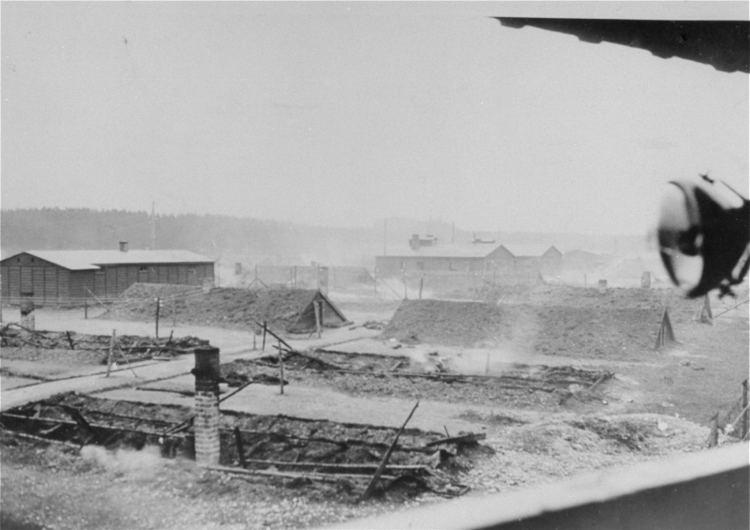 | ||
Kaufering concentration camp memorial graveyard
Kaufering concentration camps were a network of subsidiary camps of the Dachau concentration camp.
Contents
Establishment
In order to build facilities more resistant to Allied forces bombing raids, the German Armaments Ministry began construction of underground factories using the prisoners of concentration camps for labor. Smaller concentration camps were established to facilitate the excavation of tunnels into mountains and caves. Dachau had two systems of sub-camps, Kaufering and Mühldorf. Kaufering was established to create a fighter plane factory in the Landsberg region, selected for its geology. Kaufering included eleven camps, the largest containing thousands of prisoners, primarily Jewish, living in partially buried huts for camouflage from aerial reconnaissance.
Liberation
Kaufering Lager IV was discovered by soldiers of the 134th Ordinance Maintenance Battalion of the 12th Armored Division led by Capt. John P. Jones around noon on April 27, 1945. The SS began death marching prisoners to Dachau pending the US arrival and at camp IV, the SS killed hundreds of the prisoners by setting fire to the barracks. Colonel Edward F. Seiller, commander of the 12th Armored Division's Military Government, took control of the camp and had some 250 civilians from the nearby town of Landsberg brought to the camp and made them bury the dead prisoners. These 360 dead repose in a cemetery located where the roll-call area (Appell Platz) of the camp used to be, that is about a mile south of the village of Hurlach.
Six of the Kaufering Concentration Camps were liberated by the 7th Army's 103d Infantry Division, 411th Regiment on April 27, 1945. The grounds were littered with the skeletons of Jews, Poles, Russians, French and un-Nazified Germans. In two of the camps the soldiers found Jewish men, women and children shoved together, 100 to a hut. Military officers secured from the countryside 1,000 loaves of bread, 1,000 quarts of milk and 750 pounds of fresh meat per day to feed the emaciated living who weighed just 50 to 60 pounds from 5 to 6 years of forced labor, starvation and exposure. In one camp, 300 dead bodies lay on the ground while 600 "living zombies shuffled aimlessly." 411th guards forced German civilians—both men and women—to pick up the bodies of the dead prisoners for burial.
On May 7, 2000, the late Maurice Lipka of St. Die, France, a town that was itself liberated by the 103d Infantry Division on November 22, 1944, commissioned a memorial to the 103d (a/k/a The Cactus Patch.) It is located on the grounds of Kaufering VII, 1/4 mile south of Highway 26 and 1 mile west of Highway 17 in Landsberg. The field had been purchased by an association of 8 Landsberg residents in 1983 so that its sad history would not be forgotten. The marker rests behind the remains of the bunker huts and among the 10 tombstones that were commissioned by European heads of state to commemorate the Jews who were deported from their respective countries. The stones were installed on the former Appellplatz where the prisoners lined up for roll call. The marker reads "Never Again" in English, Hebrew, French and German and includes the 103d Cactus Patch insignia of a saguaro cactus.
In popular culture
Liberation of one of the Kaufering subcamps of Dachau was depicted in Episode 9 "Why We Fight" of the TV mini-series Band of Brothers, a dramatization of Easy Company of the 101st Airborne Division in the European Theater of Operations. However, the 101st Airborne Division arrived at Kaufering Lager IV subcamp on the day after it was discovered by the 134th Ordinance Maintenance Battalion of the 12th Armored Division on 27 April 1945.
